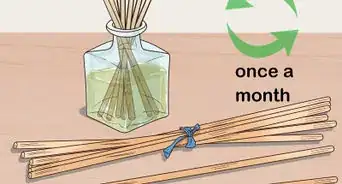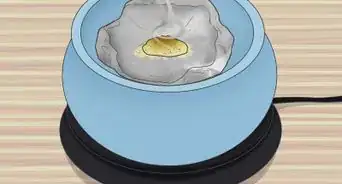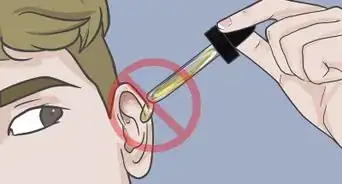This article was co-authored by Karina Klimtchuk, L.Ac., DACM, Dipl. OM. Dr. Karina Klimtchuk is a Licensed Acupuncturist, Diplomate of Oriental Medicine, Faculty Member at Yo San University of Traditional Chinese Medicine, and the Owner of Kai Wellness. She specializes in holistic health, Chinese herbal medicine, and functional medicine. Dr. Klimtchuk also helps patients through emotional and spiritual trauma. She holds a BA in Psychology and Sociology from The University of Massachusetts, Boston, a Master's from Emperor's College in Santa Monica, CA, and a Doctorate of Acupuncture and Chinese Medicine (DACM) from Pacific College of Oriental Medicine.
There are 7 references cited in this article, which can be found at the bottom of the page.
wikiHow marks an article as reader-approved once it receives enough positive feedback. This article received 11 testimonials and 90% of readers who voted found it helpful, earning it our reader-approved status.
This article has been viewed 959,740 times.
People choose to burn incense for many reasons; whether you are burning incense sticks to relax, for religious purposes, or simply because you like the smell, it's important that you know how to use them properly.
Steps
Selecting Your Incense and Censer
-
1Consider purchasing a cored incense stick. These incense sticks consist of a thin, wooden stick (usually bamboo) that is covered with incense material; only the bottom inch or so is left uncovered. The incense material can be smooth and fine, or it can be grainy and coarse. The aroma, which is usually strong, includes both the scent of the incense and the scent of the burning wooden core.
- As a general rule of thumb, opt for incense that is pure and scented naturally, rather than ones that use bonding agents and chemical fragrances.[1]
-
2Consider purchasing a solid incense stick. These incense sticks are made from pure incense material and have no core inside. They have a lighter aroma, making them perfect for small spaces, such as bedrooms and offices. Because they have no core, their smell is simpler with no underlying notes of burning wood.Advertisement
-
3Find a suitable incense holder. Incense holders, also known as censers, come in many different shapes and sizes. What you use to hold your incense depends on the type of incense you are using: cored or solid. You can purchase a special holder designed to hold incense sticks, our you can make your own using the supplies you have on hand.
- If you have a cored incense stick, consider using an incense "boat," which is a long, thin piece of wood, metal, or ceramic that has a tiny hole at one end. The incense boat usually has a groove down the center, which is used to catch any falling pieces of ash.
- If you have a solid incense stick, do not use a wooden holder. Solid incense sticks burn all the way down, so using anything made from a flammable material as a censer is dangerous. Instead, consider filling a bowl or cup with grain, rice, salt, or sand, and sticking the incense stick inside.[2] If you wish to use a censer, then look for one that is made of ceramic or stone.
- Consider purchasing a shaped censer. These incense holders often come in many different shapes, such as elephants, lotus flowers, leaves, or bowls. They are usually made out of ceramic (which makes them suitable for both cored and solid incense sticks) and have a tiny hole at the top.
-
4Consider making your own censer. You can make a simple incense holder using a bowl and something grainy, or you can make your own out of clay. Here are some ideas:
- Make a shaped censer using clay. Take a piece of natural, air dry stone clay and roll it out flat. Cut it into a shape you like using a craft knife or a cookie cutter. You can either leave it flat, or turn the edges up towards you to give it more of a bowl shape. Take your incense stick and poke a hole into the clay. Take the stick out and let the clay dry before using it as a censer.
- Make an incense holder using a bowl or bucket. Choose a container that is wide enough so that it can catch any falling ash from your incense stick. Fill the container with grain, rice, salt, or sand.
Using Your Incense
-
1Find a suitable place to burn your incense. Because incense sticks release a lot of smoke, you will need to burn your stick in a well-ventilated room. At the same time, however, keep your burning incense away from open windows or doors, where there is a lot of draft. Make sure that there is nothing flammable near your incense, such as curtains or drapes.[3]
-
2Light the end of the incense stick. You can use a match or a lighter. Hold the flame to the stick until the stick ignites.
-
3Let the flame burn for about 10 seconds.[4] The flame may extinguish on its own. If it does, look at the tip of the incense stick. If you can see a glowing ember, then the incense stick is burning properly. If you do not see anything, and the tip looks ashy, then you will need to relight the stick.
-
4Gently blow out the flame. You should be able to see a glowing ember on the tip of your incense stick and a tendril of smoke; you should not see a flame. After about 30 seconds, you should be able to smell the incense.[5] This means that your incense is burning properly. If you do not see anything and the tip looks ashy, then you have completely extinguished the incense. Re-light the stick. This time, cup your hand and hold it behind the flame as you blow it out.
-
5Stick your incense into the holder. If you are using a cored incense stick, then place the wooden end unto the holder. If you are using a solid incense stick, then it does not matter which end you place into the holder. Most censers will hold the stick up vertically or at a slight angle. If your censer holds your stick at a slight angle, make sure that the tip of your incense stick is still over the censer. If the tip extends beyond the censer, trim the incense stick down or place the censer down on a heat-resistant try.
- If you are using a bowl or bucket filled with grain, rice, salt, or sand, then gently push the bottom of the stick into the grain, rice, salt, or sand until the stick is able to stand up on its own. You can stand the stick straight up or angle it slightly. If you choose to angle the stick, make sure that the tip is still within the perimeter of the container. This way, once you light the stick, any ash will fall directly into the container, and not onto your table or floor.
-
6Let the incense burn until it extinguishes. Most incense sticks will burn for 20 to 30 minutes, depending on the size and thickness.
-
7Practice proper fire safety. Like with all flames, do not leave burning incense unattended. If you need to leave the room, extinguish the incense by dipping the tip in water or pressing it against a heat-resistant surface. Make sure that the incense holder is on a heat-resistant surface, and out of reach of any curtains, drapes, children, and pets.
Knowing When and When Not to Burn Incense
-
1Use incense for meditation. Burning incense during meditation can not only help relax your mind, but it can also help give you a sense of focus.
-
2Use incense as an air freshener. Because incense produces a lot of fragrant smoke, it is possible to use this as an air freshener. Keep in mind, however, that incense will only mask odors, and that to eliminate a bad smell completely, you will have to get rid of the source (be it the trash, dirty dishes, dirty litter, and so forth).
-
3Use incense for aromatherapy. You can use incense to help you focus, increase motivation, ease headaches, and reduce depression. Burning incense may also help you relax and feel less stressed.[6]
-
4
-
5Know that using incense too often increases indoor air pollution. The smoke from extensive incense use may deteriorate the air quality in your home, and contribute to issues such as: asthma, headaches, and other respiratory issues. It may also irritate the eyes, nose, lungs, and throat.
Warnings
- Use proper air ventilation. Too much incense smoke may cause headaches.⧼thumbs_response⧽
- Keep burning incense away from drafty areas or places where it could get knocked over.⧼thumbs_response⧽
- Keep the incense holder on a flat, heat-resistant surface. This is to reduce the risk of fire in case it gets knocked over or any ashes miss the censer as they fall.⧼thumbs_response⧽
- Never leave burning incense unattended.⧼thumbs_response⧽
Things You'll Need
- Incense
- Incense holder or censer
- Lighter or matches
References
- ↑ Karina Klimtchuk, L.Ac., DACM, Dipl. OM. Licensed Acupuncturist & Diplomate of Oriental Medicine. Expert Interview. 25 August 2021.
- ↑ Spiritual Scents, How to Burn Incense
- ↑ Incense Warehouse, Burning Incense I
- ↑ Spiriual Scents, How to Burn Incense
- ↑ Tao de Wan, Method for Burning Incense
- ↑ Tao de Wan, Benefits of Burning Incense
- ↑ WebMD, Incense Linked to Airway Cancers
- ↑ Karina Klimtchuk, L.Ac., DACM, Dipl. OM. Licensed Acupuncturist & Diplomate of Oriental Medicine. Expert Interview. 25 August 2021.
- ↑ Karina Klimtchuk, L.Ac., DACM, Dipl. OM. Licensed Acupuncturist & Diplomate of Oriental Medicine. Expert Interview. 25 August 2021.
- ↑ Karina Klimtchuk, L.Ac., DACM, Dipl. OM. Licensed Acupuncturist & Diplomate of Oriental Medicine. Expert Interview. 25 August 2021.
About This Article
To burn incense sticks, start by lighting the end of an incense stick using a lighter or a match. Then, let the end of the stick burn for about 10 seconds before gently blowing out the flame. When you blow out the flame, the end of the stick should be glowing red and smoking. If it's not, try relighting it and letting it burn for a little bit longer this time. If the incense stick is burning properly, place the non-burning end into a holder and let the incense burn until it extinguishes. To learn how to make your own incense holder, scroll down!











































































